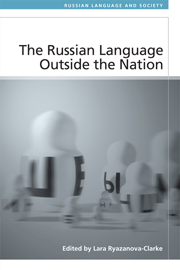Book contents
- Frontmatter
- Contents
- Notes on Contributors
- Cyrillic Transliteration System Adopted in the Book
- Introduction: The Russian Language, Challenged by Globalisation
- PART I Russian and Its Legal Status
- PART II Linguistic Perceptions and Symbolic Values
- PART III Russian-Speaking Communities and Identity Negotiations
- PART IV Language Contact and the Globalisation of Russian
- 8 Similarities and Differences between American-Immigrant Russian of the 1970s and 1980s and Post-Soviet Russian in the Motherland
- 9 Predictors of Pluricentricity: Lexical Divergences between Latvian Russian and Russian Russian
- PART V Globalisation of Russian as Soft Power
- Index
8 - Similarities and Differences between American-Immigrant Russian of the 1970s and 1980s and Post-Soviet Russian in the Motherland
from PART IV - Language Contact and the Globalisation of Russian
Published online by Cambridge University Press: 05 September 2014
- Frontmatter
- Contents
- Notes on Contributors
- Cyrillic Transliteration System Adopted in the Book
- Introduction: The Russian Language, Challenged by Globalisation
- PART I Russian and Its Legal Status
- PART II Linguistic Perceptions and Symbolic Values
- PART III Russian-Speaking Communities and Identity Negotiations
- PART IV Language Contact and the Globalisation of Russian
- 8 Similarities and Differences between American-Immigrant Russian of the 1970s and 1980s and Post-Soviet Russian in the Motherland
- 9 Predictors of Pluricentricity: Lexical Divergences between Latvian Russian and Russian Russian
- PART V Globalisation of Russian as Soft Power
- Index
Summary
INTRODUCTION
The title of this chapter, while admittedly utilitarian, is an excellent frame for the discussion of a broad and fascinating topic. In essence, the entire comparison boils down to the specific permutations of the referenced similarities and differences. The similarities have their origin in the assimilation by two speech communities of enormous sociocultural changes that were then reflected in their language. In earlier work (Andrews 1999) I have noted that the many borrowings and other English-inspired lexical innovations of Russian-speaking immigrants to the United States during the 1970s and 1980s, or the group commonly referred to as the third wave, were a precursor of linguistic developments in post-Soviet Russia. On the surface, the similarities are quite striking. The differences, of course, lie in the conditions under which these developments occurred: in the case of Russian émigrés, that of direct language contact; while in post-Soviet Russia, greater exposure to and interaction with the Western world.
For the purposes of this discussion I will use the definition of ‘language contact’ formulated by Uriel Weinreich (1953/1979), the founding scholar of this subfield: two languages are said to be in contact when a given speech community is either actively bilingual or at least regularly exposed to more than one language simultaneously. The vast majority of the third wave quickly became bilingual for sheer survival purposes, and even the relatively few (usually elderly) people who did not become proficient in English still had to deal with the language to the best of their abilities on a regular basis.
- Type
- Chapter
- Information
- The Russian Language Outside the Nation , pp. 209 - 224Publisher: Edinburgh University PressPrint publication year: 2014



